
Original Link: https://www.anandtech.com/show/1718
Athlon Dual Core: Overclocking the 4200+
The official introduction of the Dual-Core or X2 Athlon 64 happened at Computex the first of this month. As you saw on AnandTech in AMD's Athlon 64 X2 4800+ & 4200+ Dual Core Performance Preview the performance of the AMD Dual-Core desktop was stellar. The pricing, however, was a little hard to swallow with the range from just over $500 for the lowest-priced 4200+ to around $1000 for the top-line 4800+.To refresh your memory, there are really very few differences between processors in the X2 line:
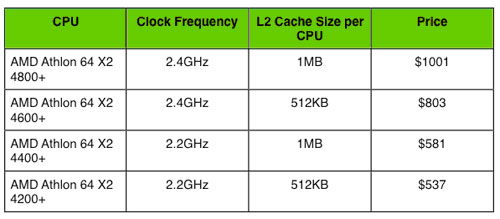
There are really just two speeds - 2.2GHz and 2.4Ghz - and either 512KB cache on each CPU or 1MB cache on each CPU. In addition nearly any Socket 939 motherboard can in theory run the new Dual-Core Athlons, as all that is required is a BIOS update.
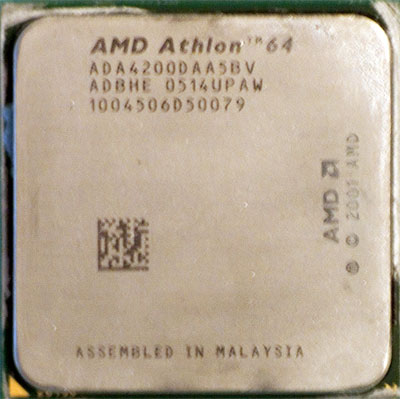
Now that the Dual-Core AMD processors are starting to appear in the market, we have received many emails asking which X2 is the best value. With prices so high that is a very fair question. To shed some light on the answer we decided to take the X2 entry level $500 4200+ to the limit on our DFI nForce4 platform to see what we could really achieve with basic air cooling of the 4200+.
The Stock and Overclock Tests
To make our performance data as useful as possible, we decided to run the stock 4200+ and the overclocked CPU through our standard motherboard test suite. As Anand has already shown in the launch article for AMD Dual-Core these are not the most revealing tests you can run on dual core. However, the test suite is a fair representation of the types of applications you run today, and it is a set of benchmarks that are very familiar to regular readers. This makes it a revealing set of tests for dual-core and overclocked dual-core performance.Performance tests were run at stock speed with the 4200+ and at the highest stable overclocked speed that could be achieved with basic air cooling on our test bed. For comparison the same suite of benchmarks were run using the single core 4000+ CPU. In looking at comparisons in the graphs, keep in mind that the 4000+ runs at 2.4GHz versus 2.2GHz for the 4200+. The 4000+ also features 1MB L2 cache compared to 512KB cache on each core in the 4200+.
The test configuration is our most recent DDR memory test bed built around the DFI LANParty nF4.
| Performance Test Configuration | |
| Processor(s) | AMD Athlon64 x2 4200+ (2.2GHz 512KB cache each) 939 AMD Athlon64 4000+ (2.4GHz 1MB Cache) Socket 939 |
| RAM | 2 x 512MB OCZ PC3200 Platinum Rev. 2 |
| Power Supply | OCZ 520 watt PowerStream |
| CPU Cooling | Thermaltake Silent Boost K8 HeatSink/Fan |
| Hard Drive | Seagate 120GB 7200 RPM SATA (8MB Buffer) |
| Video AGP & IDE Bus Master Drivers | nVidia nForce 6.39 |
| Video Card | nVidia 6800 Ultra (PCIe) |
| Video Driver | nVidia nForce 71.89 |
| Operating System | Windows XP Professional SP2; Direct X 9.0c |
| Motherboard | DFI LANParty nF4 SLI-DR |
For CPU cooling we used the same Thermaltake Silent Boost K8 HSF fan we have used for recent overclocking tests in motherboard reviews. In looking at our overclock numbers, keep in mind that cooling is just a decent stock Heatsink/Fan. Higher overclock will be achieved with more aggressive cooling like liquid cooling or phase-change.
Overclocking the 4200+
Like other "performance-rated" AMD processors, the 4200+ is locked at the top. In this case the 4200+ multiplier is fixed at a maximum of 11. As with all AMD Athlon64 processors, however, you can select ratios below 11. Only the AMD FX chips are unlocked at both the top and bottom of their range.| Front Side Bus Overclocking Testbed | |
| DFI LANParty nF4 SLI-DR | |
| Processor | Athlon 64 x2 4200+ (2.2GHz, 512KB Cache each core) |
| CPU Voltage | 1.55V (default 1.30V) |
| Cooling | Thermaltake Silent Boost K8 Heat sink/Fan |
| Power Supply | OCZ Power Stream 520W |
| Memory | OCZ PC3200 EL Platinum Rev. 2 (Samsung TCCD Memory Chips) |
| Hard Drive | Seagate 120GB 7200RPM SATA 8MB Cache |
| Maximum OC (Standard Ratio) |
245x11 (Auto HT, 2.5-3-3-7, 1T, 2.8V) 2695MHz (+22.5%) |
| Maximum FSB (Lower Ratio) |
326x8 (2608MHz) (Auto HT, 2.5-4-3-7, 2.9V) (1:1 Memory, 1T, 2 DIMMs in DC mode) (+63% Bus Overclock) |
For an early x2 Athlon64 processor the overclocking performance on air is impressive. The next speed step of 2.4GHz (4600+) was easily reached, and we moved on past the next logical step of 2.6GHz to 2.7GHz. This is faster than any of the currently available Dual-Core Athlons. We should mention that 240x11 (2.64GHz) was an extremely easy and stable reach. That speed required just 1.45V, was exceptionally stable, and ran quite cool. The last 55MHz required a great deal more voltage and generated a lot more heat. For day in and day out the 240 setting (2.64GHz) would be our choice with this CPU (stock 2.2GHz) on air.
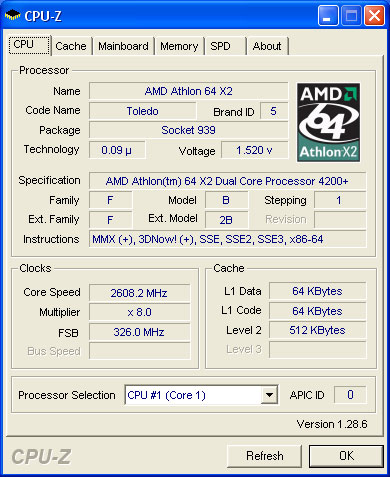
In testing for the highest CPU Frequency a new record for TCCD memory was achieved. 326 or DDR652 is the highest yet achieved with these double-sided 512MB OCZ PC3200 EL Platinum Rev 2 modules. This improved performance of the TCCD memory is likley the result of an improved memory controller on the dual-core CPU.
General Performance and Media Encoding
Winstones follow an expected pattern with Business Winstone 2004 performing about the same as a similar speed single core CPU. Multimedia Content Creation, however, has some components which benefit from the improved multitasking of the dual-core CPU and it performs better on the dual-core processor. Both Winstones scale very well with CPU speed, so we see a sizable boost in performance at the overclocked 2.7GHz setting.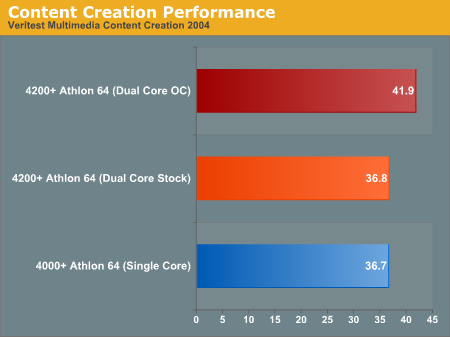
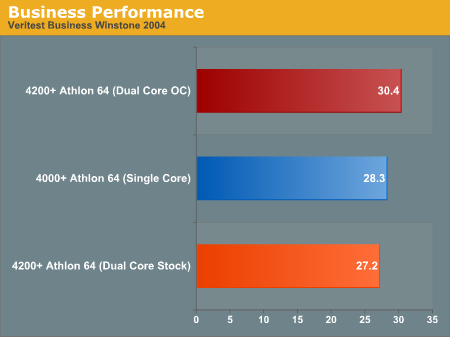

PCMark2004 is astonishingly sensitive to the multitasking advantages of the dual core 4200+. At stock speed the 4200+ outperforms the higher speed 4000+ by over 35%. PCMark2004 has performed best on the Intel platform in the past, but that advantage appears gone with the launch of the dual-core Athlon 64. We were unable, however, to get PCMark2004 to work at overclocked speeds on the X2 processor. Tests would run, but PCMark04 refused to generate a PCMark2004 score even at modest overclocks. Since Futuremark is preparing to launch PCMark2005 shortly, we suspect this anomaly will be corrected in the new version.
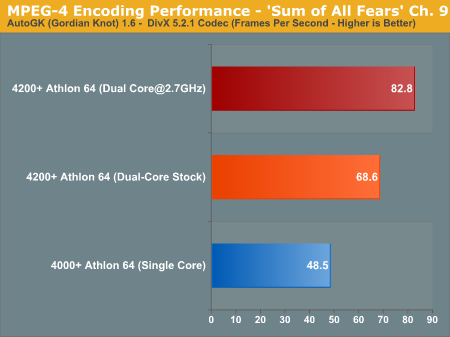
Our AutoGK 1.6 Media Encoding benchmark dramatically shows the impact of Dual-Core on Encoding speed. Comparing the 4200+ to the higher speed single-core 4000+ we find encoding jumps to 68.6 FPS from 48.5 on the single-core. This is a 41% performance improvement. Overclocking the 4200+ to 2.7GHz raises the encoding speed to 82.8 FPS.
Media Encoding was one area where Intel continued to enjoy a small advantage, but it certainly appears the dual-core Athlon 64 will be an excellent choice for media encoding.
Gaming Performance
It is very interesting that almost all the game benchmarks are slightly higher on the 2.4GHz 1MB cache 4000+ than on the 4200+ Dual-Core (2.2GHz with 512KB Cache on each core). As Anand pointed out in the X2 launch article, this is in line with AMD's claims. Gaming today is heavily single threaded and the dual core performs about the same as a similar speed single core. However, the difference between the 4000+ and 4200+ is generally very small.Most of the gaming benchmarks respond very well with the X2 overclock to 2.7GHz and yield impressive performance returns with the extra 500MHz.
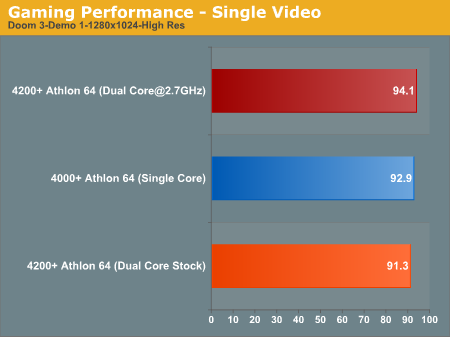
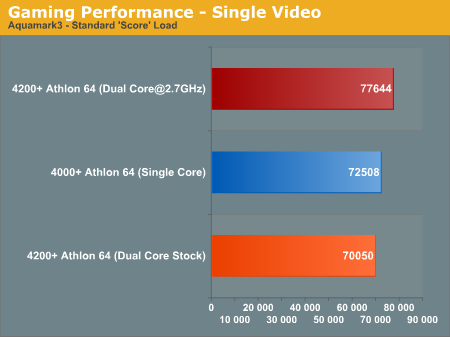

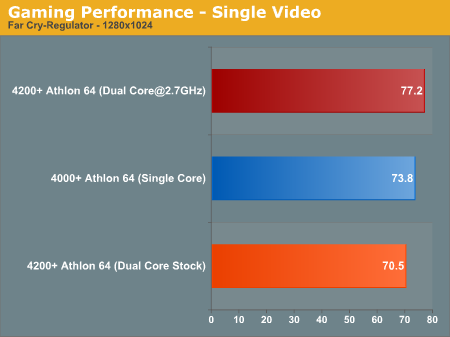
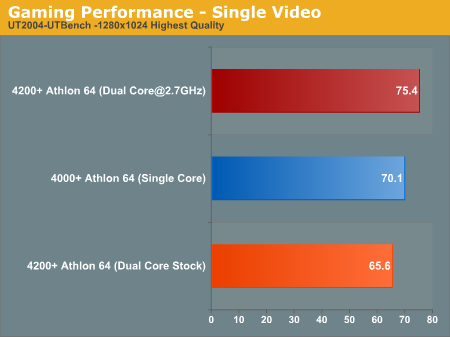
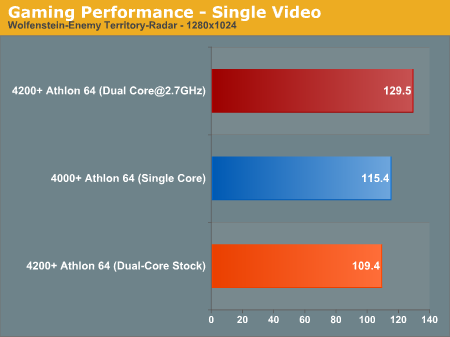
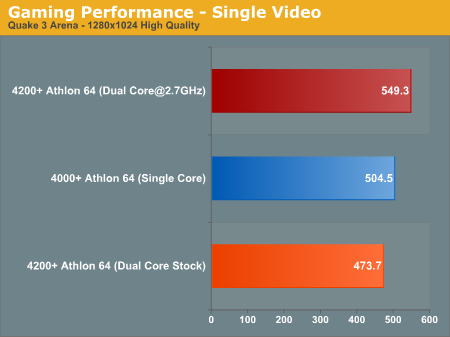
Looking closely it is very interesting that two of the most recent games, Doom 3 and Half Life 2, seem to have their performance almost entirely dictated by the graphics card. With the increases in graphics power we tested all games at 1280x1024 where possible. Whether 2.2GHz, 2.4GHz with double the cache, or 2.7GHz, Doom 3 and Half Life 2 performed about the same using the same graphics card at the same 1280x1024 resolution.
The game benchmarks we use for memory testing were much more responsive to processor speed increases. Wolfenstein ET saw a 18.4% increase in a 22.5% CPU speed boost, and Q3 increased 16%. UT2004 performed similarly at 16%, while Far Cry was in-between at 9.5%. These results should give you a good idea of why we use Wolfenstein-ET and Q3 for memory benchmarking.
3D Workstation Performance
Specviewperf performance was much like that seen in games. The Dual-Core performed about the same as a similar speed single core processor. The 500MHz speed increase provided performance increases in most benchmarks in the SPECviewperf 8.01 test suite. The exceptions are proe-03, sw-01, and ugs-04 which all seemed more tied in performance to the graphics card used for the benchmarking.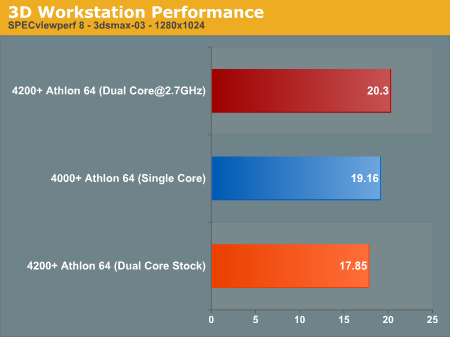

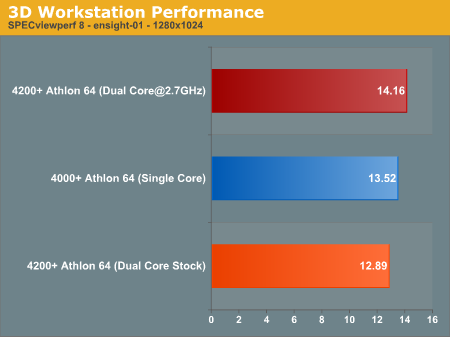
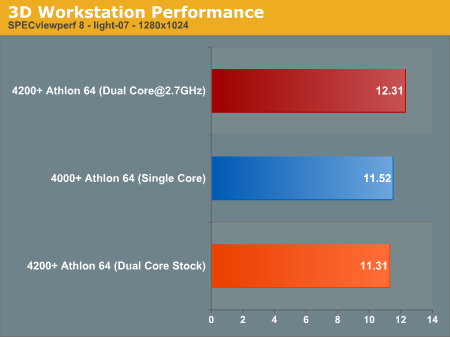


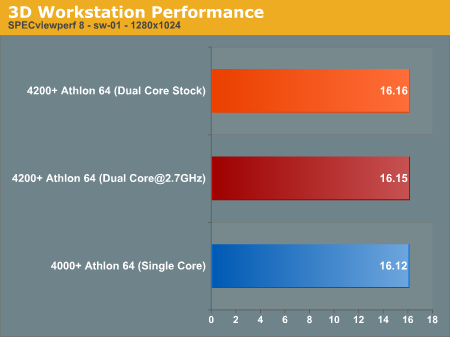
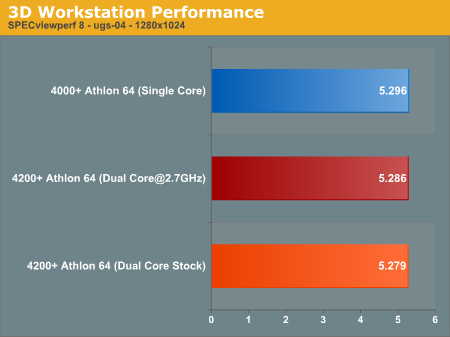
Final Words
The 4200+ is the least expensive of the new Athlon 64 Dual-Core processors, but $500 is only cheap compared to the other members of the X2 line which can cost as much as $1000 to own. The good news is the 4200+ performs very well on its own. It performs about like a similar speed single core in gaming and 3D workstation tasks, which means it is a little slower than the 4000+ in these heavily single-threaded tasks. If you are a gamer, and that is all you care about on your PC, then the Dual-Core processors will hold no advantage for you over the current single-core models. Performance does not suffer to any great extent compared to single-core, but you need another use for dual-core to tip the scales in the more expensive dual-core direction.When even a bit of multitasking comes into play, however, the 4200+ soars ahead, with significant performance advantages in the general performance PCMark2004 benchmark and an advantage in Multimedia Content Creation 2004. Media Encoding is one particular area where the x2 4200+ shines, outperforming the higher speed 4000+ by 41% at stock speed and by almost 71% when overclocked to 2.7GHz. The performance advantage for Dual-Core in Media Encoding is so significant that the X2 becomes a "must-have" if you do much media encoding.
These results are all while running in Windows XP, and there should be even further performance improvement in the 64-bit version of XP. Until there are useful benchmarks that really take advantage of the 64-bit OS we can only speculate on 64-bit performance, but the clean implementation of 64-bit by AMD should definitely yield performance advantages in 64-bit. The advantages should be similar to those AnandTech found for Opteron in the recent article comparing processors in 64-bit Linux.
The point of this article though is OVERCLOCKING the 4200+, and there is more good news there. Our early 4000+ processors only overclocked about 11 to 12% at stock multiplier. We do have a later 4000+ (that is likely an FX55 at heart) that overclocks about 18% at stock multiplier, which is the one we use in memory reviews. This 4200+, a new speed grade, is doing 22.5% at the start, reaching 2.7GHz on air. That's a 500MHz overclock, and is 300MHz higher than the fastest x2 you can buy (2.4GHz 4800+ and 4600+). This kind of overclocking performance makes the 4200+ a much more attractive option at the $500 you will pay for it - since it will likely reach higher performance levels that a stock 4800+.
You can likely do even better than we have if you use more exotic cooling. We have seen many reports on the web of the 4200+ reaching 2.8GHz or even 3.0GHz. We have also seen reports of the 4800+ reaching even a bit higher, so even better overclocks may be available with a 4800+. Anand is reaching 2.8GHz on air with the 4800+ he has been testing.
In the end the 4200+ appears to be a good-performing dual-core CPU with quite a bit of overclocking headroom. We reached 2.7GHz with a PC Health reported CPU temperature of 61 degrees C at 1.55V. 240 was a breeze at 1.45V, exceptionally stable for days on end, with processor temps generally below 50C with our air cooling. It appears an easy task to reach the highest levels of Dual-Core performance with the cheapest 4200+ if you are willing to overclock a little - and the 4200+ is up to the task.
The 4200+ running OC at 2.4GHz is equivalent to a 4600+, which brings us back to the question of which x2 Athlon 64 we would buy for ourselves. With the 4400+ sporting 1MB cache on each core, and only a few dollars more than the 512KB 4200+, we would suspect the 4400+ may well be the Dual-Core to buy - IF it overclocks as well as the 4200+. We don't have a 4400+ to test for ourselves, but given the performance of the 1MB cache 4800+ we have seen, we expect the 4400+ will likely overclock just as well.







